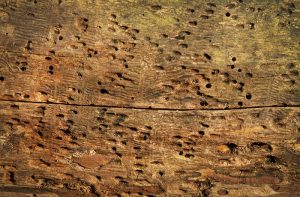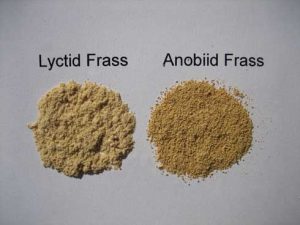Powderpost beetles are a group of wood-boring pests that infest homes and cause significant damage to property. These pests are especially dangerous since their larvae can dwell within wood structures for years before being detected. To prevent serious damage from powderpost pests, homeowners need to look for early signs of infestation and also implement preventative measures.
What are Wood-boring Powderpost Beetles?
Since powderpost beetles include a wide variety of wood-boring pests, about 70 species to be exact, homeowners may come across many different species. Though some species differ significantly in size or anatomy, one thing is clear:

Damage done by powderpost beetle
they all love wood. The beetles in their pre-adult stages, particularly as larvae, burrow into various forms of wood and consume it, leaving powdery droppings called frass in their wake.
Some of the most common species are the lyctid and anobiid powderpost beetles. These differ in appearance, with the lyctid beetles possessing a narrow, long body while the anobiid variety is more oblong. Both measure less than an inch long.
Once the powderpost beetles complete their development, the adult beetles chew into the wood until they reach the surface. They create exit holes about 1/8 inch in diameter through which they escape. This is usually the main sign of infestation, in addition to the powdery frass these insects produce. The fact that these signs occur during the advanced stage of infestation means that homeowners are less likely to see these wood-boring beetles until most of the damage has already been done. Thankfully, there are many preventative and control measures available to homeowners that will reduce the likelihood of damage from powderpost beetle infestation.
How to Prevent Powderpost Beetle Infestation within your Home
Since adult powderpost bugs often lay their eggs at the surface of or within the unfinished wood, it is very important that homeowners assess the quality of wood within their home. Be sure to inspect both hardwood and softwood, especially if you are in the process of purchasing a new home. Hiring a pest control expert in such a case or acquiring

Frass of Powderpost Beetles
evidence that the home has been inspected by a certified pest control professional will help homeowners be prepared to prevent any infestation from occurring.
Areas of the home which should be accessed include plywood, hardwood flooring, any wood-based framing, door and window frames, paneling, etc. Also, have the inspection verify which type of wood is used and determine which wood-boring powderpost species would likely infest that kind of wood. For instance, lyctid beetles are most likely to infest oak, walnut, or hickory wood structures. Anobiid powderpost beetles, on the other hand, are most likely to infest pine, poplar, and maple wood.
In addition to inspecting wood-based structures within one’s home, also be sure to control moisture levels as some powderpost beetles are more inclined to infest damp or moist wood. To control moisture levels in home, check and fix leaks, use a dehumidifier for the basement or crawlspaces and install vents and attic fans where necessary.
Homeowners may also prevent infestation by ensuring that the firewood they use is not infested with woodboring beetles. Inspect all firewood before use, especially if stored outdoors, as they may be susceptible to infestation from woodboring powderpost pests.
How to Control Powderpost Infestation
To control infestation among powderpost beetles, homeowners will need to determine if there is an active infestation. Verify if the infestation is active by looking for signs of fresh frass or exit holes. Another indication involves the sound of feeding. Once an active infestation is occurring, homeowners may take the following pest control steps:
- Remove and replace infested wood. This includes any form of hardwood or softwood infested by powderpost beetle species such as cabinets, wall studs, and flooring.
- Fumigate furniture or wood structures. This process involves the use of gaseous pesticides called fumigants which poison the powderpost beetles. Consider this option if the infestation is very severe. It will require the use of a pest control professional.
- Apply liquid insecticide to infested wood. This process also requires the help of qualified pest control personnel. They will be equipped with the knowledge required to determine which type of pesticide is necessary based on the species of powderpost beetles present.

No Comments